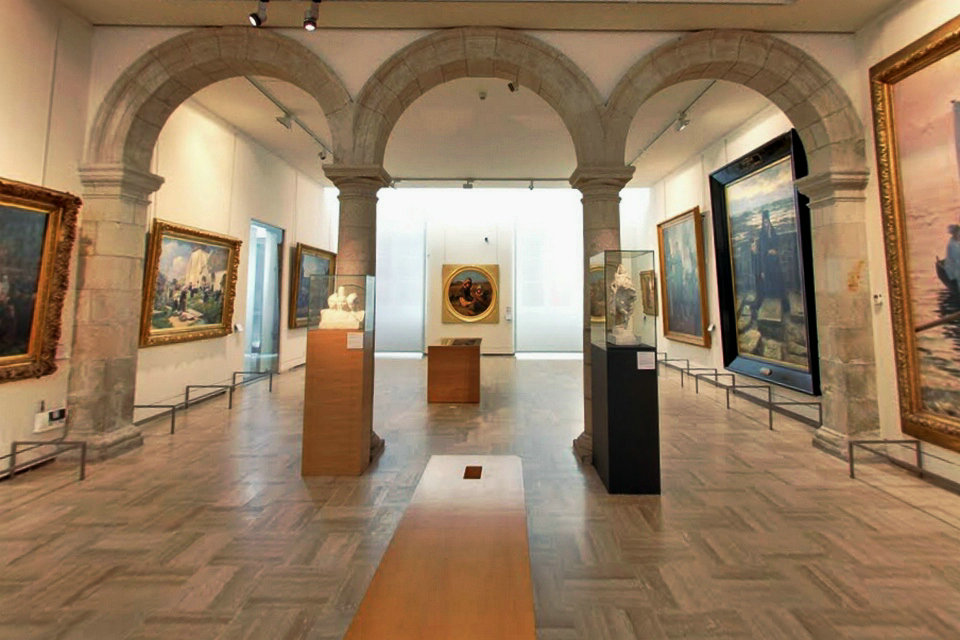Breton-inspired painting, famous since their creation in the 19th century, make up this collection. One of a kind , and perfectly representative of the last fires of realism and its extensions via naturalism, it was patiently formed by the first curators after the opening of the museum in 1872. Today it offers an extremely varied and often just from a world that has disappeared or strongly evolved.
Among the most spectacular works, we will retain, without seeking exhaustiveness, L e Pardon de Kergoat by Jules Breton, a Widow of the Island by Emile Renouf, the Visit to the Virgin of Bénodet by Eugène Buland, several large and beautiful paintings by Théophile Deyrolle or Alfred Guillou, or more recently acquired: the superb Moissonneuses, Île de Bréhat by Pierre Dupuis.
Without forgetting the Lemordant room which in a way constitutes the heart of the museum. Its woodwork serves as a framework for the grand decor created in 1906-1909 by Jean-Julien Lemordant (1878 – 1968) for the Café de l’Epée in Quimper.
From romanticism to symbolism
Among the masterpieces of the 19th century in France, the dazzling portrait of Marie-Thérèse de Cabarrus painted by Théodore Chassériau is worth mentioning ; for the landscape, the very subtle Vue du Château de Pierrefonds by Camille Corot or for the large genre the two Wilhelm List, major artist of the Viennese Secession.
History scenes, genre scenes
For the first decades of the 19th century, the museum presents numerous small formats oscillating between scenes of history and scenes of genre and often representative of what is called troubadour art. The whole forms a coherent whole from the studies of Léopold Boilly through the more developed canvases of Georges Rouget or the vibrant sketch by Eugène Devéria, La Birth d’Henri IV + , which allows us to approach the romantic movement. Remarkably, the museum keeps for this period a decorative ensemble of primary importance (not currently exhibited due to lack of space) designed in 1825 for one of the rooms of the Council of State then housed in the Louvre. The whole is perfectly representative of an official art where allegory serves the interests of the State.
The landscape
The section developing the art of landscape is essential in that it extends the neoclassical section and ensures the transition with the new formulas developed in Pont-Aven. Numerous and attractive works make it possible to follow the attractiveness of the Breton coasts on number of artists since Théodore Gudin, Emmanuel Lansyer, Paul Huet, until the View of the port of Quimper by Eugène Boudin. A special mention must be reserved for the painter Jules Noël whose museum keeps a significant set of works.
Symbolism
The presentation of the 19th century finds its conclusion (apart from the Pont-Aven School and the section dedicated to the “Black band”) with a small set which proceeds from the Symbolist movement. The two essential works of Wilhelm List are essential but we can easily complete them with creations by Lucien Lévy-Dhurmer, Henry Lerolle, Maurice Chabas, Eugène Carrière… The whole is enriched by several important paintings by an artist with a strong temperament, Yan’Dargent, whose work demonstrates his attachment to Finistère.
Musée des Beaux-Arts de Quimper
The Quimper Fine Arts Museum is an art museum located in Quimper. It was born in 1864, thanks to Count Jean-Marie de Silguy who bequeathed his entire collection to his hometown, on the sole condition that a museum be built there to accommodate his paintings and drawings. It is now one of the major museums of art in western France, with rich French painting collections (especially 19th century), Italian, Flemish and Dutch of the xiv th century to today.
In the middle of the 19th century, Quimper, Finistère prefecture and capital of Cornwall, is a modest city of 12,000 inhabitants. It can be compared to regional capitals like Rennes and Nantes, where are created in the late eighteenth th or early 19th century the first museum collections from seizures among emigrants of Church property and deposits Central Museum of the Arts.
In Quimper, considered by Jacques Cambry as a “city without fortune and without enthusiasm for the arts”, the painter François Valentin (1738–1805) tried, during the course, to create a museum from some old works recovered in the region. But without means and without enough works, his project failed. In the middle of the 19th century, the eyes are more likely to archeology and local history. In 1862, the General Council of Finistère voted the principle of the creation in Quimper of a departmental museum, devoted essentially to Finistère archeology, which would receive the collections gathered since 1845 by a learned, archaeological society of Finistère, and kept in a room in the girls’ college.
With the exception of the towns of Saint-Malo which, in 1861, undertook to collect some portraits and historical memories, and of Vannes where archaeological objects gathered by polymath from Morbihan have been stored since 1826, no museum exists in Brittany in the west of the Rennes-Nantes line when Quimper decided to create a museum of fine arts in 1864.
This creation is exceptional. It is not a question of regrouping some local works and some State deposits, but of receiving the considerable collection of Jean-Marie de Silguy which has just disappeared: 1,200 paintings, 2,000 drawings, 12,000 engravings and several dozen of art objects.



